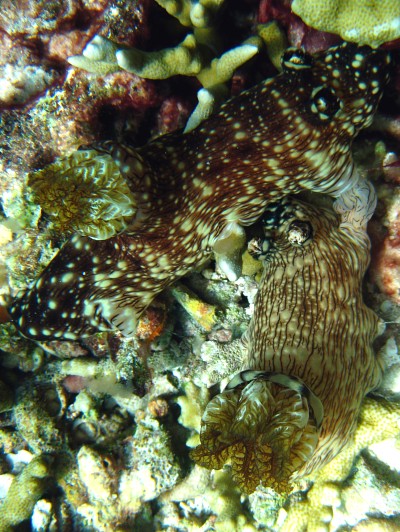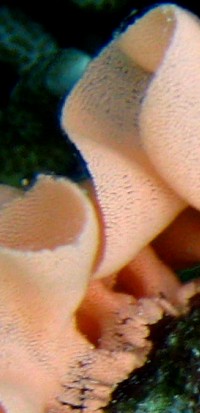Giant nudies mating - Thailand
May 13, 2010
From: Ingrid Dolensky

Hi,
Please find attached some photos of the "giant nudies" of Koh Haa Lagoon mating. They are the size of a ladies forearm (25-35cm).
We think they are Jorunna rubescens, and they seem similar to the photos of these that you have so far, though none of them seem as fond of branching coral as these.
A local dive instructor friend of ours first noticed these last year amongst the fire coral beds of Koh Haa lagoon in March/April 2009. As this is a very popular dive site we were all suprised that we had not noticed them before, as many of my divemaster and instructor friends have been diving there for years.
There were many of them on 2009, with many pink egg ribbons giving away their camouflage (10 or more nudies found in 10 minutes). They were all sitting on the top of the fire coral at this time (the ones we could see).
When I returned later in the year, I could not find them from October 2009-January 2010. Returning to dive in the lagoon in Feb/March 2010 they had returned. These were the only two I found on the dive where I had my camera.
My instructor friends that stay all year advise me they only see them at this time of the year for a few weeks. We think maybe they are underneath the fire coral or somewhere else the rest of the year, as they only appear when their eggs are around (although their camouflage is very good against the coral here).
Their rhinospores are a soft pink-rose colour when out, which they are not in these photos (maybe because they are mating?).
Locality: Koh Haa Lagoon, 8m, Thailand, Andaman Sea, 25 February 2010, branching coral area of lagoon with sand underneath. Length: 30 cm. Photographer: I. Dolensky.
Ingrid Dolensky
redfish44@yahoo.co.uk



Dear Ingrid,
Yes these are Jorunna rubescens. Although this species grows to quite a large size I suspect it has an annual life cycle which means you are only likely to see it as it grows in size and perhaps like sea hares congregate to mate. Certainly in Tanzania I have seen it in huge congegrations in shallow reefal lagoons laying great numbers of their typical pink egg ribbons.
Best wishes,
Bill Rudman
Related messages
-
Jorunna rubescens from Reunion Island
From: Hugues Flodrops, September 4, 2008 -
Re: Jorunna rubescens from the Philippines
From: Marcel Tanke, August 26, 2008 -
Jorunna rubescens from Pemba Island
From: Wilhelm van Zyl, March 7, 2006 -
Re: Jorunna rubescens from Bali
From: Roberto Sozzani, February 15, 2006 -
Jorunna rubescens from Bali
From: Marli Wakeling, February 7, 2006 -
Jorunna rubescens from the Maldives
From: Charles Rowe, May 29, 2005 -
Jorunna rubescens from Reunion island
From: Philibert Bidgrain, February 22, 2005 -
Jorunna rubescens from Anilao, The Philippines
From: Paul Osmond, February 17, 2005 -
Kentrodoris rubescens with one rhinophore
From: Danny Van Belle, February 3, 2003 -
Record of Kentrodoris rubescens
From: Fredy Brauchli, July 3, 2002 -
Kentrodoris rubescens from Bali
From: Stuart Hutchison, February 21, 2002 -
Kentrodoris rubescens from Papua New Guinea
From: Mary Jane Adams, December 12, 2001 -
Kentrodoris rubescens from Bootless Bay, PNG
From: Tim Murrell , December 11, 2001 -
Kentrodoris rubescens mating
From: Tim Murrell , December 11, 2001 -
Kentrodoris rubescens from Philippines
From: Erwin Koehler, February 20, 2000 -
Kentrodoris rubescens from Vanuatu
From: Vinka Stenhouse, February 20, 2000
